- ホーム
- > 電子洋書
Description
Provides a comprehensive and updated study of GARCH models and their applications in finance, covering new developments in the discipline
This book provides a comprehensive and systematic approach to understanding GARCH time series models and their applications whilst presenting the most advanced results concerning the theory and practical aspects of GARCH. The probability structure of standard GARCH models is studied in detail as well as statistical inference such as identification, estimation, and tests. The book also provides new coverage of several extensions such as multivariate models, looks at financial applications, and explores the very validation of the models used.
GARCH Models: Structure, Statistical Inference and Financial Applications, 2nd Edition features a new chapter on Parameter-Driven Volatility Models, which covers Stochastic Volatility Models and Markov Switching Volatility Models. A second new chapter titled Alternative Models for the Conditional Variance contains a section on Stochastic Recurrence Equations and additional material on EGARCH, Log-GARCH, GAS, MIDAS, and intraday volatility models, among others. The book is also updated with a more complete discussion of multivariate GARCH; a new section on Cholesky GARCH; a larger emphasis on the inference of multivariate GARCH models; a new set of corrected problems available online; and an up-to-date list of references.
- Features up-to-date coverage of the current research in the probability, statistics, and econometric theory of GARCH models
- Covers significant developments in the field, especially in multivariate models
- Contains completely renewed chapters with new topics and results
- Handles both theoretical and applied aspects
- Applies to researchers in different fields (time series, econometrics, finance)
- Includes numerous illustrations and applications to real financial series
- Presents a large collection of exercises with corrections
- Supplemented by a supporting website featuring R codes, Fortran programs, data sets and Problems with corrections
GARCH Models, 2nd Edition is an authoritative, state-of-the-art reference that is ideal for graduate students, researchers, and practitioners in business and finance seeking to broaden their skills of understanding of econometric time series models.
Table of Contents
Preface to the Second Edition xi
Preface to the First Edition xiii
Notation xv
1 Classical Time Series Models and Financial Series 1
1.1 Stationary Processes 1
1.2 ARMA and ARIMA Models 3
1.3 Financial Series 6
1.4 Random Variance Models 10
1.5 Bibliographical Notes 11
1.6 Exercises 12
Part I Univariate GARCH Models
2 GARCH(p, q) Processes 17
2.1 Definitions and Representations 17
2.2 Stationarity Study 22
2.2.1 The GARCH(1,1) Case 22
2.2.2 The General Case 26
2.3 ARCH(∞) Representation* 36
2.3.1 Existence Conditions 36
2.3.2 ARCH(∞) Representation of a GARCH 39
2.3.3 Long-Memory ARCH 40
2.4 Properties of the Marginal Distribution 41
2.4.1 Even-Order Moments 42
2.4.2 Kurtosis 45
2.5 Autocovariances of the Squares of a GARCH 46
2.5.1 Positivity of the Autocovariances 47
2.5.2 The Autocovariances Do Not Always Decrease 48
2.5.3 Explicit Computation of the Autocovariances of the Squares 48
2.6 Theoretical Predictions 50
2.7 Bibliographical Notes 54
2.8 Exercises 55
3 Mixing* 59
3.1 Markov Chains with Continuous State Space 59
3.2 Mixing Properties of GARCH Processes 64
3.3 Bibliographical Notes 71
3.4 Exercises 71
4 Alternative Models for the Conditional Variance 73
4.1 Stochastic Recurrence Equation (SRE) 74
4.2 Exponential GARCH Model 77
4.3 Log-GARCH Model 82
4.3.1 Stationarity of the Extended Log-GARCH Model 83
4.3.2 Existence of Moments and Log-Moments 86
4.3.3 Relations with the EGARCH Model 88
4.4 Threshold GARCH Model 90
4.5 Asymmetric Power GARCH Model 96
4.6 Other Asymmetric GARCH Models 98
4.7 A GARCH Model with Contemporaneous Conditional Asymmetry 99
4.8 Empirical Comparisons of Asymmetric GARCH Formulations 101
4.9 Models Incorporating External Information 109
4.10 Models Based on the Score: GAS and Beta-t-(E)GARCH 113
4.11 GARCH-type Models for Observations Other Than Returns 115
4.12 Complementary Bibliographical Notes 119
4.13 Exercises 120
Part II Statistical Inference
5 Identification 125
5.1 Autocorrelation Check for White Noise 125
5.1.1 Behaviour of the Sample Autocorrelations of a GARCH Process 126
5.1.2 Portmanteau Tests 128
5.1.3 Sample Partial Autocorrelations of a GARCH 129
5.1.4 Numerical Illustrations 129
5.2 Identifying the ARMA Orders of an ARMA-GARCH 132
5.2.1 Sample Autocorrelations of an ARMA-GARCH 132
5.2.2 Sample Autocorrelations of an ARMA-GARCH Process When the Noise is Not Symmetrically Distributed 136
5.2.3 Identifying the Orders (P, Q) 138
5.3 Identifying the GARCH Orders of an ARMA-GARCH Model 140
5.3.1 Corner Method in the GARCH Case 141
5.3.2 Applications 141
5.4 Lagrange Multiplier Test for Conditional Homoscedasticity 143
5.4.1 General Form of the LM Test 143
5.4.2 LM Test for Conditional Homoscedasticity 147
5.5 Application to Real Series 149
5.6 Bibliographical Notes 151
5.7 Exercises 158
6 Estimating ARCH Models by Least Squares 161
6.1 Estimation of ARCH(q) models by Ordinary Least Squares 161
6.2 Estimation of ARCH(q) Models by Feasible Generalised Least Squares 165
6.3 Estimation by Constrained Ordinary Least Squares 168
6.3.1 Properties of the Constrained OLS Estimator 169
6.3.2 Computation of the Constrained OLS Estimator 170
6.4 Bibliographical Notes 171
6.5 Exercises 171
7 Estimating GARCH Models by Quasi-Maximum Likelihood 175
7.1 Conditional Quasi-Likelihood 175
7.1.1 Asymptotic Properties of the QMLE 177
7.1.2 The ARCH(1) Case: Numerical Evaluation of the Asymptotic Variance 180
7.1.3 The Non-stationary ARCH(1) 181
7.2 Estimation of ARMA–GARCH Models by Quasi-Maximum Likelihood 183
7.3 Application to Real Data 187
7.4 Proofs of the Asymptotic Results* 188
7.5 Bibliographical Notes 211
7.6 Exercises 212
8 Tests Based on the Likelihood 217
8.1 Test of the Second-Order Stationarity Assumption 217
8.2 Asymptotic Distribution of the QML When 𝜃0 is at the Boundary 218
8.3 Significance of the GARCH Coefficients 226
8.3.1 Tests and Rejection Regions 226
8.3.2 Modification of the Standard Tests 227
8.3.3 Test for the Nullity of One Coefficient 228
8.3.4 Conditional Homoscedasticity Tests with ARCH Models 230
8.3.5 Asymptotic Comparison of the Tests 232
8.4 Diagnostic Checking with Portmanteau Tests 235
8.5 Application: Is the GARCH(1,1) Model Overrepresented? 235
8.6 Proofs of the Main Results* 238
8.7 Bibliographical Notes 245
8.8 Exercises 246
9 Optimal Inference and Alternatives to the QMLE* 249
9.1 Maximum Likelihood Estimator 249
9.1.1 Asymptotic Behaviour 250
9.1.2 One-Step Efficient Estimator 252
9.1.3 Semiparametric Models and Adaptive Estimators 254
9.1.4 Local Asymptotic Normality 256
9.2 Maximum Likelihood Estimator with Mis-specified Density 260
9.2.1 Condition for the Convergence of 𝜃n,h to 𝜃0 261
9.2.2 Convergence of 𝜃n,h and Interpretation of the Limit 262
9.2.3 Choice of Instrumental Density h 263
9.2.4 Asymptotic Distribution of 𝜃n,h 264
9.3 Alternative Estimation Methods 265
9.3.1 Weighted LSE for the ARMA Parameters 265
9.3.2 Self-Weighted QMLE 266
9.3.3 Lp Estimators 267
9.3.4 Least Absolute Value Estimation 267
9.3.5 Whittle Estimator 268
9.4 Bibliographical Notes 268
9.5 Exercises 269
Part III Extensions and Applications
10 Multivariate GARCH Processes 273
10.1 Multivariate Stationary Processes 273
10.2 Multivariate GARCH Models 275
10.2.1 Diagonal Model 276
10.2.2 Vector GARCH Model 276
10.2.3 Constant Conditional Correlations Models 279
10.2.4 Dynamic Conditional Correlations Models 280
10.2.5 BEKK-GARCH Model 281
10.2.6 Factor GARCH Models 284
10.2.7 Cholesky GARCH 286
10.3 Stationarity 287
10.3.1 Stationarity of VEC and BEKK Models 287
10.3.2 Stationarity of the CCC Model 289
10.3.3 Stationarity of DCC models 292
10.4 QML Estimation of General MGARCH 292
10.5 Estimation of the CCC Model 294
10.5.1 Identifiability Conditions 295
10.5.2 Asymptotic Properties of the QMLE of the CCC-GARCH model 297
10.6 Looking for Numerically Feasible Estimation Methods 299
10.6.1 Variance Targeting Estimation 299
10.6.2 Equation-by-Equation Estimation 300
10.7 Proofs of the Asymptotic Results 303
10.7.1 Proof of the CAN in Theorem 10.7 303
10.7.2 Proof of the CAN in Theorems 10.8 and 10.9 307
10.8 Bibliographical Notes 312
10.9 Exercises 313
11 Financial Applications 317
11.1 Relation Between GARCH and Continuous-Time Models 317
11.1.1 Some Properties of Stochastic Differential Equations 317
11.1.2 Convergence of Markov Chains to Diffusions 319
11.2 Option Pricing 324
11.2.1 Derivatives and Options 324
11.2.2 The Black–Scholes Approach 325
11.2.3 Historic Volatility and Implied Volatilities 326
11.2.4 Option Pricing when the Underlying Process is a GARCH 327
11.3 Value at Risk and Other Risk Measures 331
11.3.1 Value at Risk 332
11.3.2 Other Risk Measures 336
11.3.3 Estimation Methods 338
11.4 Bibliographical Notes 340
11.5 Exercises 342
12 Parameter-Driven Volatility Models 345
12.1 Stochastic Volatility Models 346
12.1.1 Definition of the Canonical SV Model 346
12.1.2 Stationarity 347
12.1.3 Autocovariance Structures 349
12.1.4 Extensions of the Canonical SV Model 350
12.1.5 Quasi-Maximum Likelihood Estimation 352
12.2 Markov Switching Volatility Models 353
12.2.1 Hidden Markov Models 353
12.2.2 MS-GARCH(p, q) Process 362
12.3 Bibliographical Notes 363
12.4 Exercises 365
A Ergodicity, Martingales, Mixing 367
A.1 Ergodicity 367
A.2 Martingale Increments 368
A.3 Mixing 371
A.3.1 α-Mixing and β-Mixing Coefficients 371
A.3.2 Covariance Inequality 373
A.3.3 Central Limit Theorem 375
B Autocorrelation and Partial Autocorrelation 377
B.1 Partial Autocorrelation 377
B.1.1 Computation Algorithm 378
B.1.2 Behaviour of the Empirical Partial Autocorrelation 379
B.2 Generalised Bartlett Formula for Non-linear Processes 382
C Markov Chains on Countable State Spaces 387
C.1 Definition of a Markov Chain 387
C.2 Transition Probabilities 388
C.3 Classification of States 388
C.4 Invariant Probability and Stationarity 389
C.5 Ergodic Results 390
C.6 Limit Distributions 390
C.7 Examples 391
D The Kalman Filter 393
D.1 General Form of the Kalman Filter 394
D.2 Prediction and Smoothing with the Kalman Filter 396
D.3 Kalman Filter in the Stationary Case 398
D.4 Statistical Inference with the Kalman Filter 399
E Solutions to the Exercises 401
References 467
Index 485
-

- 電子書籍
- ホテル・メッツァペウラへようこそ【分冊…
-

- 電子書籍
- げんこつやまの たぬきさん
-

- 電子書籍
- エンタープライズアプリケーションアーキ…
-

- 電子書籍
- 【分冊版】花のズボラ飯 1 エレガンス…
-

- 電子書籍
- ロンタイBABY(11)



